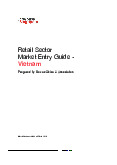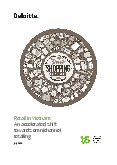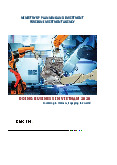



















Preview text:
Springer Texts in Business and Economics Efraim Turban David King Jae Kyu Lee Ting-Peng Liang Deborrah C. Turban Electronic Commerce A Managerial and Social Networks Perspective
Eighth Edition, Revised Edition Springer Texts in Business and Economics
More information about this series at http:/ www.springer.com/series/10099
Overview of Electronic Commerce 1 Contents
Learning Objectives
Opening Case: How Starbucks
Upon completion of this chapter, you wil be
Is Changing to a Digital
and Social Enterprise ............................................... 3 able to: 1.1
1. Defi ne electronic commerce (EC) and
Electronic Commerce: Defi nitions
and Concepts ................................................... 7
describe its various categories.
2. Describe and discuss the content and frame-
1.2 The Electronic Commerce Field: work of EC.
Growth, Content, Classifi cation,
and a Brief History .......................................... 8 3. Describe the major types of EC transactions. 1.3
4. Describe the drivers of EC.
Drivers and Benefi ts of E-Commerce ............ 15 5. Discuss the benefi ts of EC to individuals,
1.4 E-Commerce 2.0: From Social organizations, and society.
Commerce to Virtual Worlds ......................... 16 6. Discuss e-commerce 2.0 and social media.
1.5 The Digital and Social Worlds:
7. Describe social commerce and social software.
Economy, Enterprises, and Society ............... 20 8. Understand the elements of the digital world.
1.6 The Changing Business Environment,
9. Describe the major environmental business
Organizational Responses, and EC
pressures and organizational responses.
and IT Support ................................................ 27 10. Describe some EC business models.
1.7 Electronic Commerce Business Models ........ 31 11. List and describe the major limitations of EC.
1.8 The Limitations, Impacts,
and the Future of E-Commerce ..................... 34
1.9 Overview of This Book ................................... 37 OPENING CASE: HOW STARBUCKS
IS CHANGING TO A DIGITAL
Managerial Issues..................................................... 38 AND SOCIAL ENTERPRISE
Closing Case: E-Commerce
at the National Football League (NFL) .................. 43 Starbucks is the world’s largest coffee house
chain, with about 20,800 stores in 63 countries
(see Loeb 2013 ). Many people view Starbucks as
a traditional store where customers drop in, enter
an order, pay cash or by credit card for coffee or
Electronic supplementary material The online version other products, consume their choices in the
of this chapter (doi: 10.1007/978-3-319-10091-3_1 ) store, and go on about their business. The last
contains supplementary material, which is available to authorized users
thing many people think about is the utilization
E. Turban et al., Electronic Commerce: A Managerial and Social Networks Perspective, 3
Springer Texts in Business and Economics, DOI 10.1007/978-3-319-10091-3_1,
© Springer International Publishing Switzerland 2015 4
1 Overview of Electronic Commerce
of computers in this business. The opposite is coffee, tea, and Starbucks equipment and mer-
actual y true. Starbucks is turning itself into a chandise. The store was in operation for years,
digital and social company (Van Grove 2012 ).
using typical shopping cart (cal ed My Bag), but
For a long time Starbucks was known as the company completely redesigned the webstore
appealing to young people because the free Wi-Fi to make shopping more convenient and easy (in
Internet access provided in its U.S. and Canada August 2011). In addition, customers (individual
stores. But lately the company embarked on or companies) can schedule deliveries of stan-
several digital initiatives to become a truly dard and special items. Customers can order rare technology- savvy company.
and exquisite coffee that is available only in some
U.S. stores. Now customers around the U.S. and
the world can enjoy it too. Final y, online cus- The Problem
tomers get exclusive promotions.
Starting in 2007, the company’s operating income The eGift Card Program
declined sharply (from over $1 bil ion in 2007 to Customers can buy Starbucks customized gift
$504 mil ion in 2008 and $560 mil ion in 2009). cards digital y (e.g., a gift card for a friend’s
This decline was caused by not only the eco- birthday is auto delivered on the desired date).
nomic slowdown, but also by the increased com- Payments can be made with a credit card or
petition (e.g., from Green Mountain Coffee PayPal. The gift card is sent to the recipient via
Roasters), which intensifi ed even during the e-mail or postal mail.
recession. Excel ent coffee and service helped
The recipients can print the card and go shop-
but only in the short run. A bet er solution was ping at a Starbucks physical store, transfer the needed.
gift amount to their Starbucks’ payment card, or
Starbucks realized that bet er interaction with to Starbuck Card Mobile.
its customers was necessary and decided to solve the problem via digitization. Loyalty Program
Like airlines and other vendors, the company
offers a Loyalty Program (My Starbucks Rewards).
The Solution: Going Digital
Those who reach the gold level receive extra ben- and Social
efi ts. The program is managed electronical y.
In addition to traditional measures to improve its Mobile Payments
operation and margin, the company resorted to Customers can pay at Starbucks stores with pre-
electronic commerce , meaning the use of com- paid (stored value) cards, similar to those used in
puterized systems to conduct and support its transportation, or conduct smartphone payments.
business. The company appointed a Senior
Executive with the title of Chief Digital Offi cer to Paying from Smartphones
oversee its digital activities. It also created the Starbucks customers can also pay for purchases in
Digital Venture Group to conduct the technical physical stores with their mobile devices. Payments implementation.
can be made by each of two technologies:
• Using Starbucks mobile app . Shoppers have
The Electronic Commerce Initiatives
an app on their mobile device. Payment is
Starbucks deployed several e-commerce projects,
made by selecting “touch to pay” and holding the major ones are follow.
up the barcode on the device screen to a scan-
ner at the sel er’s register. The system is Online Store
connected automatical y to a debit or credit
Starbucks sel s a smal number of products online
card. The system works only in the company-
at store.starbucks.com . These offerings include owned stores.
Opening Case: How Starbucks Is Changing to a Digital and Social Enterprise 5 The Social Media Projects
see current statistics at starcount.com/chart/
Starbucks realized the importance of social media wiki/Starbucks/today and at facebook.com/
that uses Internet-based systems to support social Starbucks . Starbucks offers one of the best
interactions and user involvement and engage- online marketing communication experiences on
ment (Chapter 7 ). Thus, it started several initia- Facebook to date as wel as mobile commerce
tives to foster customer relationships based on engagements. Starbucks posts information on its
the needs, wants, and preferences of its existing Facebook “wal ” whether it is content, ques-
and future customers. The following are some tions, or updates. The company is also advertis- representative activities.
ing on its Facebook homepage. Note that
Starbucks is assessing the cost-benefi t of such
Exploiting Collective Intelligence advertising.
Mystarbucksidea.com is a platform in which
a community of over 300,000 consumers and Starbucks’ Presence in LinkedIn
employees can make improvement sugges- and Google+
tions, vote for the suggestions, ask questions, Starbucks has a profi le on the LinkedIn site with
collaborate on projects, and express their com- over 500,000 fol owers (July 2014). It provides
plaints and frustrations. The community gener- business data about the company, lists new hires
ated 70,000 ideas in its fi rst year, ranging from in managerial positions, and advertises available
thoughts on the company’s rewards cards and managerial jobs. Starbucks is also active on
elimination of paper cups to ways to improve Google+.
customer service. The site also provides statistics
on the ideas generated, by category, as wel as Starbucks Actions on Twitter
their status (under review, reviewed, in the works, In February 2015, Starbucks had over 2.7 mil ion
and launched). The company may provide incen- fol owers (Fol ow@starbucks) on Twit er orga-
tives for certain generated ideas. For example, in nized in 18,025 lists (e.g., @starbucks/friends).
June 2010, Starbucks offered $20,000 for the best Each ‘list’ has its own followers and tweets.
idea concerning the reuse of its used coffee cups. Whenever the company has some new update or
This initiative is based on the technology of col- marketing campaign, the company encourages
lective intelligence also known as crowdsourcing conversation on Twit er. By October 2013,
(see Chapters 2 and 8 ) and it is supported by the Starbucks was the number one retailer to follow following blog.
Twit er. As of November 2013, Starbucks sends
$5 gift cards to Twit er friends and followers.
Starbucks Idea in Action Blog
This blog is writ en by employees who discuss Starbucks’ Activities on YouTube, Flickr,
what the company is doing about ideas submit ed Pinterest, and Instagram to MyStarbucksIdea site.
Starbucks has a presence on both YouTube
( youtube.com/starbucks and Flickr ( fl ickr.com/
Starbucks’ Activities on Facebook
starbucks , with a selection of videos and photos
Ful y integrated into Facebook, Starbucks prac- for view. It also runs advertising campaigns
tices several social commerce activities there. there. Final y, Starbucks has about 4 mil ion fol-
The site was built with input from Starbucks cus- lowers on the photo-sharing company-Instagram
tomers. The company uploads videos, blog ( instagram.com/Starbucks ).
posts, photos, promotions, product highlights,
and special deals. The mil ions of people who Starbucks Digital Network
like Starbucks on Facebook verify that it is one To support its digital activities the company
of the most popular companies on Facebook offers online content using Starbucks Digital
with about 36 mil ion fol owers (February 2014), Network in partnership with major media 6
1 Overview of Electronic Commerce
providers (e.g., New York Times , iTunes). It is force.com , and blogs.starbucks.com (both
designed for al major mobile devices including accessed May 2014).
tablets (e.g., iPad) and smartphones. The net-
work’s content features news, entertainment,
business, health, and local neighborhood infor-
LESSONS LEARNED FROM THE CASE mation channels.
The Starbucks.com case il ustrates the
Early Adoption of Foursquare: A Failure
story of a large retailer that is converting to
Not al Starbucks social media projects were
be a digital and social enterprise. Doing
successes. For example, the company decided to
business electronical y is one of the major
be an early adopter of geolocation by working
activities of e-commerce, the subject of this
with Foursquare (Chapter 7 ). The initiative sim-
book. The case demonstrates several of the
ply did not work, and the project ended in mid-
topics you wil learn about in this chapter
2010 (see Teicher 2010 for an analysis of the
and throughout the book. These are:
reasons). The company experimented in the
1. There are multiple activities in EC
UK with a similar location company cal ed
including sel ing online, customer ser-
Placecast. As of fal 2011, Starbucks had a bet-
vice, and collaborative intel igence.
ter understanding of the opportunities and the
2. The case shows major benefi ts both to
limitations, so it may decide to try geolocation
buyers and sel ers. This is typical in EC.
again with Facebook’s Places, or it may revive
3. The EC capabilities include the ability the Foursquare project.
to offer products and services in many
locations, including overseas to many
customers, individuals, and businesses. The Results
You can do so because online your cus-
tomer base is huge, and people can buy
According to York ( 2010 ), Starbucks turned from anywhere at any time.
around sales by effectively integrating the digital
4. In a regular store you pay and pick up
and the physical worlds. In 2010, its operating
the merchandise or service. In Starbucks.
income almost tripled ($1.437 bil ion versus
com and other webstores you order, pay,
$560 mil ion in 2009) and so did its stock price.
and the product is shipped to you.
In 2011, the operating income reached $1.7 bil-
Therefore, order fulfi l ment needs to be
lion. Since then the operating income is increas- very effi cient and timely. ing rapidly.
5. Being a digital enterprise can be very
The company’s social media initiatives are
useful, but a greater benefi t can be
widely recognized. In 2012 it was listed by
achieved by extending it to be social y-
Fortune Magazine as one of top social media
oriented enterprise. Both approaches
stars (Fortune 2012 ), and in 2008 it was awarded
constitute the backbone of electronic
the 2008 Groundswel Award by Forrester
commerce, the subject of this book.
Research. The site is very popular on Facebook
where it has mil ions of fans, (sometimes more
popular than pop icon Lady Gaga). Starbucks
In this opening chapter, we describe the essen-
at ributes its success to 10 philosophical guide- tials of EC, some of which were presented in this
lines that drive its social media efforts (see case. We present some of the drivers and benefi ts Belicove 2010 for details).
of EC and explain their impact on the technology.
Sources: Based on Belicove ( 2010 ), Special at ention is provided to the emergence of
York ( 2010 ), Cal ari ( 2010 ), Van Grove ( 2012 ), the social economy, social networks, and social
Loeb ( 2013 ), Gembarski ( 2012 ), Marsden ( 2010 ), enterprises. Final y, we describe the outline of
Teicher ( 2010 ), Walsh ( 2010 ), mystarbucks. this book.
1.1 Electronic Commerce: Defi nitions and Concepts 7 Major EC Concepts 1.1 ELECTRONIC COMMERCE:
DEFINITIONS AND CONCEPTS
Several other concepts are frequently used in con-
junction with EC. The major ones are as fol ows.
As early as 2002, the management guru Peter
Drucker ( 2002 ) forecasted that e-commerce (EC) Pure Versus Partial EC
would signifi cantly impact the way that business EC can be either pure or partial depending on the
is done. And indeed the world is embracing EC, nature of its three major activities: ordering and
which makes Drucker’s prediction a reality.
payments, order fulfi l ment, and delivery to cus-
tomers. Each activity can be physical or digital.
Thus, there are eight possible combinations as
Defi ning Electronic Commerce
shown in Table 1.1 . If al activities are digital, we
have pure EC, if none are digital we have no EC,
Electronic commerce (EC) refers to using the otherwise we have partial EC.
Internet and intranets to purchase, sel , transport,
If there is at least one digital dimension, we
or trade data, goods, or services. For an overview, consider the situation EC, but only partial EC. For
see Plunket et al. ( 2014 ). Also watch the video example, purchasing a computer from Del ’s titled
website or a book from Amazon.com is partial
“What is E-Commerce?” at youtube.com/ EC, because the merchandise is physical y deliv-
watch?v=3wZw2IRb0Vg . EC is often confused ered. However, buying an e-book from Amazon.
with e-business, which is defi ned next.
com or a software product from Buy.com is pure
EC, because ordering, processing, and delivery to
the buyer are al digital. Note that many compa- Defi ning E-Business
nies operate in two or more of the classifi cations.
For example, Jaguar has a 3D application for self
Some people view the term commerce as describ- confi guration of cars online, prior to shopping
ing only buying and sel ing transactions con- (see Vizard 2013 ). For a video titled “Introduction
ducted between business partners. If this to E-Commerce” see plunkettresearch.com/
defi nition of commerce is used, the term elec- video/ecommerce .
tronic commerce would be fairly narrow. Thus,
many use the term e-business instead. E-business EC Organizations
refers to a broader defi nition of EC, not just the Purely physical organizations (companies) are
buying and sel ing of goods and services, but referred to as brick-and-mortar ( or o ld econ-
conducting al kinds of business online such as omy) organizations , whereas companies that are
servicing customers, collaborating with business engaged only in EC are considered virtual (pure-
partners, delivering e-learning, and conducting play) organizations. Click-and-mortar (c lick-
electronic transactions within an organization. and- brick ) o rganizations are those that conduct
However, others view e-business only as com-
prising those activities that do not involve buying
or sel ing over the Internet, such as collaboration Table 1.1 Classifi cations of E-Commerce
and intra-business activities; that is, it is a com- Activity 1 2 3 4 5 6 7 8
plement of the narrowly defi ned e-commerce. In Ordering, P D D D D P P P
its narrow defi nitions e-commerce can be viewed Payment Order P D D P P D P D
as a subset of e-business. In this book, we use the fulfi l ment
broadest meaning of electronic commerce, which Delivery P D P P D D D D
is basical y equivalent to the broadest defi nition (shipment)
of e-business. The two terms wil be used inter- Type of EC Non EC Pure EC Partial EC
changeably throughout the text.
Legend: P physical, D digital 8
1 Overview of Electronic Commerce
some EC activities, usual y as an additional mar- Notice the sharp increase in manufacturing com-
keting channel. Gradual y, many brick-and- mortar pared to other sectors. Also note that EC is grow-
companies are changing to click-and-mortar ones ing much faster than the total of al commerce by (e.g., GAP, Target).
about 16–17% annual y. For a more detailed
breakdown, see the U.S. Census Bureau ( 2013 )
report as wel as Plunket et al. ( 2014 ).
Electronic Markets and Networks
There is a clear trend that online retail sales
are taking business from traditional retailers.
EC can be conducted in an electronic market Knight ( 2013 ) reported that during the 2009–
(e-marketplace) , an online location where buy- 2013 economic diffi culty EC sales reached
ers and sel ers conduct commercial transactions double- digit growth. For example, Wilfred ( 2014 )
such as sel ing goods, services, or information. reported that during the 2013 holiday shopping
Any individual can also open a market sel ing season online shopping grew 10% a year versus
products or services online. Electronic markets 2.7% of traditional retailers.
are connected to sel ers and buyers via the
According to Ecommerce Europe , September
Internet or to its counterpart within organiza- 5, 2012, European online retail sales wil double
tions, an intranet . An intranet is a corporate or to 323 bi € l ion in 5 years (2018).
government internal network that uses Internet
tools, such as Web browsers and Internet proto-
cols. Another computer environment is an The Content and Framework
extranet , a network that uses Internet technology of E-Commerce
to link intranets of several organizations in a
secure manner (see Online Tutorial T2).
Classifying e-commerce aids understanding of
this diversifi ed fi eld. In general, sel ing and buy-
SECTION 1.1 REVIEW QUESTIONS
ing electronical y can be either business-to-
1. Defi ne EC and e-business.
consumer (B2C) or business-to-business (B2B).
2. Distinguish between pure and partial EC.
Online transactions are made between businesses
3. Defi ne click-and-mortar and brick-and-mortar and individual consumers in B2C, such as when a organizations.
person purchases a coffee at store.starbucks.com
4. Defi ne electronic markets.
or a computer at dell.com (see Online File W1.1).
5. Defi ne intranets and extranets.
In B2B, business transactions are made online
with other businesses, such as when Del elec-
tronical y buys parts from its suppliers. Del also 1.2
THE ELECTRONIC COMMERCE
collaborates electronical y with its partners and
FIELD: GROWTH, CONTENT,
provides customer service online e-CRM (see
CLASSIFICATION, AND A BRIEF Online Tutorial T1). Several other types of EC HISTORY
wil be described later in this chapter.
According to the U.S. Census Bureau ( 2013 ),
According to the U.S. Census Bureau ( 2013 ), the total EC shipments grew 16.5% in a year,
e-commerce sales in 2011 accounted for 49.3% of ComScore reported (cited by BizReport 2012 )
total sales of al manufacturing activities in the that U.S. retail commerce online increased 17%
United States, 24.3% of merchant wholesalers, in QI 2012 as compared to a year earlier. EC is
4.7% of al retailing, and 2% of al sales in selected growing in al areas. For example, Leggat ( 2012 )
service industries. The grand total of EC in 2010 reported that in the UK Domino’s Pizza online
has been $3,545 bil ion, of which $3,161 bil ion sales grew about 1,000% between 2000 and
was B2B (89%) and $385 bil ion was B2C (11%). 2012. Similar results can be found in many indus-
The results over 9 years are shown in Figure 1.1 . tries, companies, and countries (e.g., see periodic
1.2 The Electronic Commerce Field: Growth, Content, Classifi cation, and a Brief History 9 60.0% 50.0% 40.0% 30.0% 20.0% 10.0% 0.0% 2003 2004 2005 2006 2007 2008 2009 2010 2011 Selected Services Retail Trade Merchant Wholesale Trade Manufacturing
Figure 1.1 E-Co mmerce as percent of total value: (2003–2011) (Source: Census.gov/estats Accessed February 2014)
reports at ComScore and BizReport) and Ahmad
( 2014 , an Infographic). E-Commerce is explod-
1. People. Sel ers, buyers, intermediaries,
ing global y. According to a press release of
information systems and technology
ecommerce- europe.eu/press of May 23, 2013,
specialists, other employees, and any
European e-commerce grew by 19% in 2012 other participants.
reaching €312 bil ion. According to Stanley and
2. Public policy. Legal and other policy
Ritacca ( 2014 ), e-commerce in China is explod-
and regulatory issues, such as privacy
ing, reaching $600 bil ion by the end of 2013.
protection and taxation, which are
Final y, in several developing countries EC is
determined by governments. Included
becoming a major economic asset (e.g., see
are technical standards and compliance.
Maitra 2013 for information on India).
3. Marketing and advertising. Like any
other business, EC usual y requires the
support of marketing and advertising. An EC Framework
This is especial y important in B2C online
transactions, in which the buyers and sel -
The EC fi eld is diverse involving many activi-
ers usual y do not know each other.
ties, organizational units, and technologies.
4. Support services. Many services are
Therefore, a framework that describes its con-
needed to support EC. These range from
tents can be useful. Figure 1.2 introduces one
content creation to payments to order such framework. delivery.
As shown in the fi gure, there are many EC
5. Business partnerships. Joint ventures,
applications (top of fi gure), which wil be il us-
exchanges, and business partnerships of
trated throughout the book. To perform these
various types are common in EC. These
applications, companies need the right informa-
occur frequently throughout the supply
tion, infrastructure, and support services.
chain (i.e., the interactions between a
Figure 1.2 shows that EC applications are sup-
company and its suppliers, customers,
ported by infrastructure and by the following fi ve and other partners).
support areas (shown as pil ars in the fi gure): 10
1 Overview of Electronic Commerce
Figure 1.2 A framework for electronic commerce
The infrastructure for EC is shown at the
A common classifi cation of EC is by the type
bottom of the fi gure. Infrastructure describes the of the transactions and the transacting members.
hardware, software, and networks used in EC. Al The major types of EC transactions are listed
of these components require good management below.
practices . This means that companies need to
plan, organize, motivate, devise strategy, and Business-to-Business (B2B)
restructure processes, as needed, to optimize the Business-to-business (B2B) EC refers to trans-
business use of EC models and strategies.
actions between and among organizations. Today,
about 85% of EC volume is B2B. For Del , the
entire wholesale transaction is B2B. Del buys
Classifi cation of EC by the Nature
most of its parts through e-commerce, and sel s of the Transactions
its products to businesses (B2B) and individuals
and the Relationships Among (B2C) using e-commerce. Participants Business-to-Consumer (B2C)
Note: Several of the fol owing defi nitions are sim- Business-to-consumer (B2C) EC includes retail
ilar to those of Katic and Pusara ( 2004 ), whose EC transactions of products or services from busi-
terminology is based on the 2003 edition of this book. nesses to individual shoppers. The typical shopper




